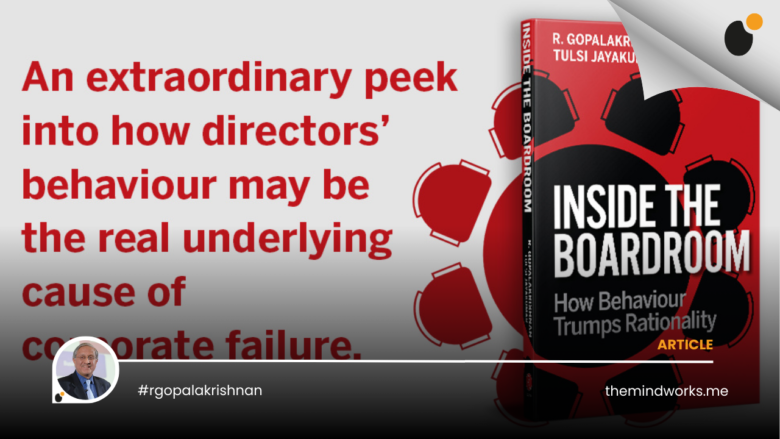To appear on 10-8-22
BS The Wise Leader (55)
Bequeathing leaders’ experiential wealth
By R. Gopalakrishnan*
*The writer is an author and a business commentator. His articles and videos can be accessed at his website www.themindworks.me and his email ID is rgopal@themindworks.me
During their career, executives and leaders acquire some financial assets, but lots of experiential assets. They bequeath financial assets as late as possible. Experiential assets get interred with their bones, to borrow from the Mark Antony speech in Shakespeare’s Julius Caesar. The “richest” real estate lies in the crematorium and cemetery, even though, unlike financial assets, experiential assets increase by sharing and distribution. But how can a leader share the experiential asset?
The sharing of experiential assets requires the person to upgrade that asset into a customer-friendly form. The person must think through how to extract, process, distribute and market the value of the asset. Too often, experiential asset holders undervalue their asset and doubt that anyone might be interested to learn from a retired factory manager or a regional sales manager. There is, however, always a target group that benefits, be it big or small. Further, if a person does not know how to process and package the asset into a consumer-friendly format, it gets interred without benefitting those that it can benefit.
Experiential assets are akin to bulk food grains, undistinguished and indistinct. Value is added to food grain through a five-step process by (i) processing it into flour, (ii) cooking the flour interestingly, (iii) adding spices or tasty ingredients, (iv) packing in an interesting manner, and (v) distributing it widely. These skills exist in the domain of fast-moving consumer goods, FMCG.
For FMCG skills to be applied to experiential assets, the asset-owner must feel motivated and disciplined to do so. The person must train in processing and marketing methods as applicable to experiences. Increasingly these days, what with computers, word processors, google searches, and easier referencing methods, there is access to techniques and data bases.
A few weeks ago, in his Saturday Ruminations, TN Ninan wrote about two genres of books by retired IAS and IFS fraternity. IAS folks write in the first person about how they played on the field, whereas the IFS folks write in the third person about the field and what they have observed. Interesting.
In the world of Indian business and enterprise too, there appear to be two genres—first, private sector professionals, who write about the field on which they have played, resembling the IFS; second, entrepreneurs/public sector professionals, who write about their own roles. Resembling the IAS genre, entrepreneurs/public sector managers write often in the first person on how “we did it and what we learned”. Although the genres have overlap, each book belongs to a dominant genre. I mention about ten books in each to highlight the difference.
In the 1970s, Arabinda Ray of Metal Box wrote about the “Indian manager in search of a style.” Sharu Rangnekar of Union Carbide wrote “In the wonderland of the Indian manager.” Prakash Tandon of Unilever, later of PNB, wrote a trilogy “Punjabi Saga.” Ashok Ganguly of Unilever wrote “Business-driven R & D”, drawing on his international experiences in linking scientific research with enterprise. Gurcharan Das of P&G wrote several books including “The difficulty of being good”. Nandan Nilekani wrote on “Imagining India” and “Rebooting India”. N Chandrasekharan of Tata wrote “Bridgital Nation”, while his Tata colleague, Harish Bhat, wrote four books including “The Curious Marketer.” Banker Naina Lal Kidwai wrote about “30 women in power”. Ravi Venkatesan of Cummins and Microsoft wrote “Conquering the chaos” and “What the heck do I do with my life.” Ambi Parameswaran of Ulka, Bharat Wakhlu of Tata, Kulbhushan Girotra, also of Tata, and Sudhir Sitapati of HUL too have written books. Saving my blushes, I mention my own output of seventeen books–so far!
Among public sector and entrepreneurs, DV Kapur wrote “The bloom in the desert.” Arundhati Bhattacharya and Rajnish Kumar wrote separately about their years in SBI. S Ramadorai wrote “The TCS story” while Narotam Sekhsaria wrote “The Ambuja story.” Sunil Munjal wrote “The Making of Hero”. AM Naik wrote “The Nationalist.” Harsh Mariwala wrote “Harsh Realities.” Among startup entrepreneurs, there is K Vaitheeswaran’ s book “Failing to succeed”, TN Hari’s “Saying No to jugaad”, and Ronnie Screwalla’s “Dream with your eyes open.” This genre does run the natural danger of becoming a “boast seller and an I-witness report,” though some authors avert this danger.
New formats, other than books, have been spurred by digital technology—podcasts, interviews, speeches, and videos.
How can a leader bequeath experiential assets, considering that the skill set required is different? By seeking help from storytellers (yes, a new profession), media professionals, analysts, and management academics. HR professionals and B-Schools can contribute by interviewing multiple leaders and drawing hypotheses as illustrated by the Harvard CEM project (Creating Emerging Markets). Also, by writing up case studies, inviting guest lectures, and writing blog posts. The Indian market for processed, packaged, and well marketed experiential content is undoubtedly large, and potentially enriching to the giver and the taker.
Every writer does not have to be a Jack Welch or Bill Gates. It is to noteworthy that international writers are prolific—Dale Carnegie 10 plus books, Ram Charan 30 plus books, and Peter Drucker 35 plus books. Therefore, the Indian runway will be long for well-produced content.
As Mark Twain perceptively quipped, “History doesn’t repeat itself, but it often rhymes.”



